Abstract
BACKGROUND AND AIMS: It has been reported that eradication of Helicobacter pylori improves fold width in H pylori associated enlarged fold gastritis. The aim of this study was to clarify the mechanism of fold thickening in this condition. PATIENTS AND METHODS: In eight patients with enlarged fold gastritis and 13 patients without enlarged folds, the presence of H pylori infection, inflammatory infiltrates, mucosal plasia, and epithelial cell proliferation in the body mucosa were investigated, and production of transforming growth factor alpha (TGF alpha), hepatocyte growth factor (HGF), and interleukin 1 beta (IL 1 beta) was determined by a competitive reverse transcription/polymerase chain reaction method and in vitro short-term culture of biopsy specimens. RESULTS: In the patients with enlarged fold gastritis, inflammatory infiltrates including macrophages increased with H pylori colonisation in the body. Foveolar thickness and proliferating cell nuclear antigen (PCNA) labelling index were increased. Messenger RNA levels of HGF, but not TGF alpha, were increased, and release of HGF and IL 1 beta was increased. HGF release, which was positively correlated with IL 1 beta release and foveolar thickness, decreased in the presence of IL 1 receptor antagonist. After eradication of H pylori, inflammatory infiltrates, IL 1 beta and HGF release decreased with concomitant decreases in PCNA labelling index, foveolar thickness and fold width. CONCLUSIONS: Increased IL 1 beta and HGF production caused by H pylori infection may contribute to fold thickening of the stomach by stimulating epithelial cell proliferation and foveolar hyperplasia in patients with enlarged fold gastritis.
Full text
PDF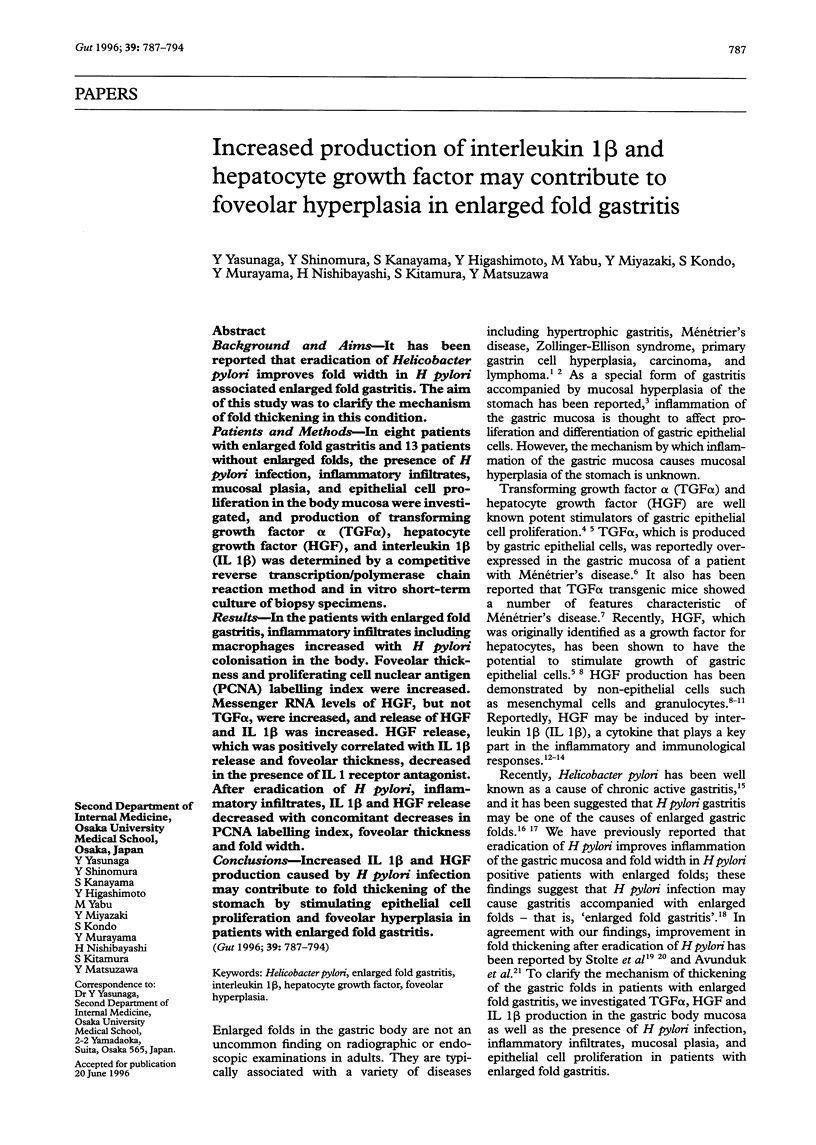
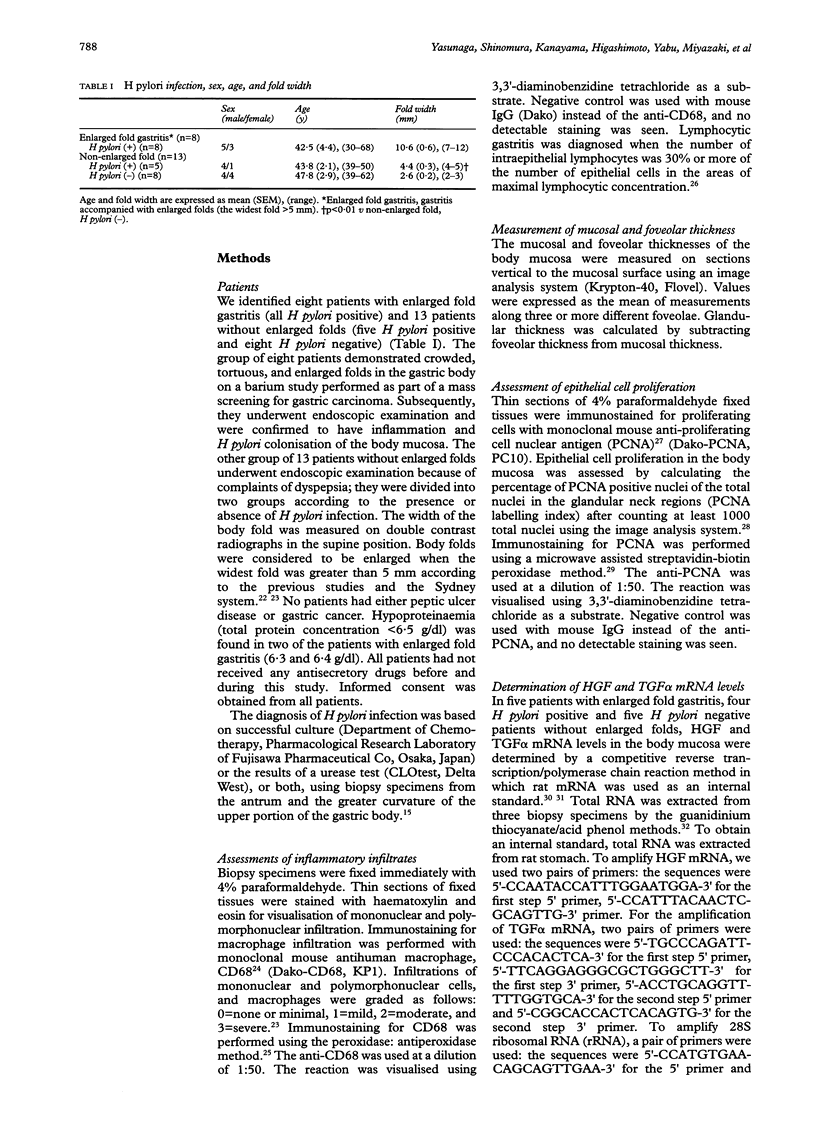
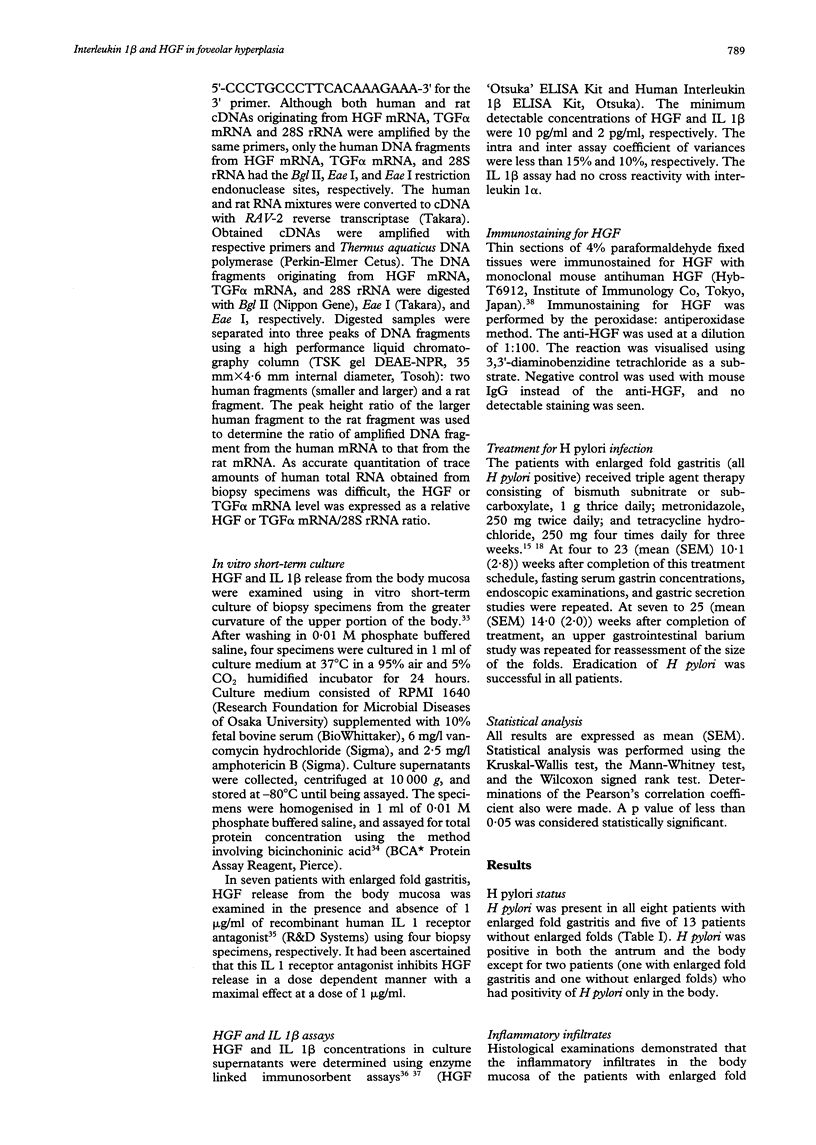
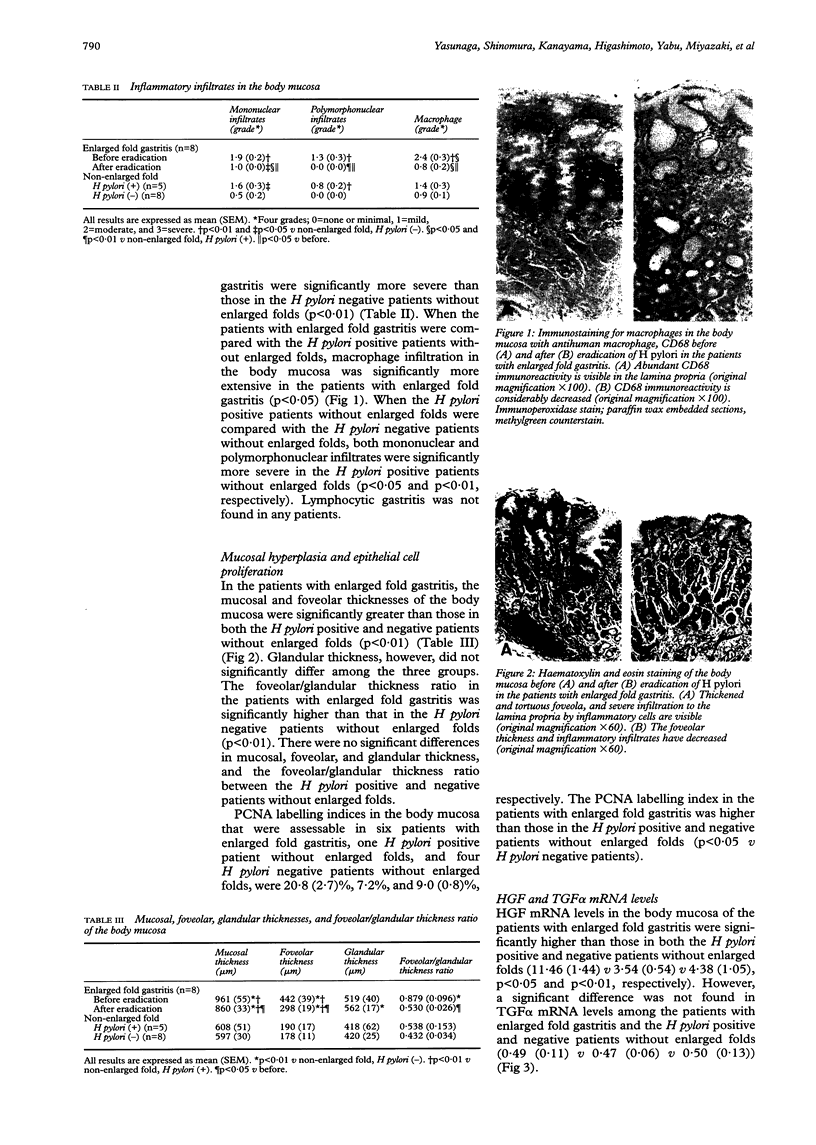
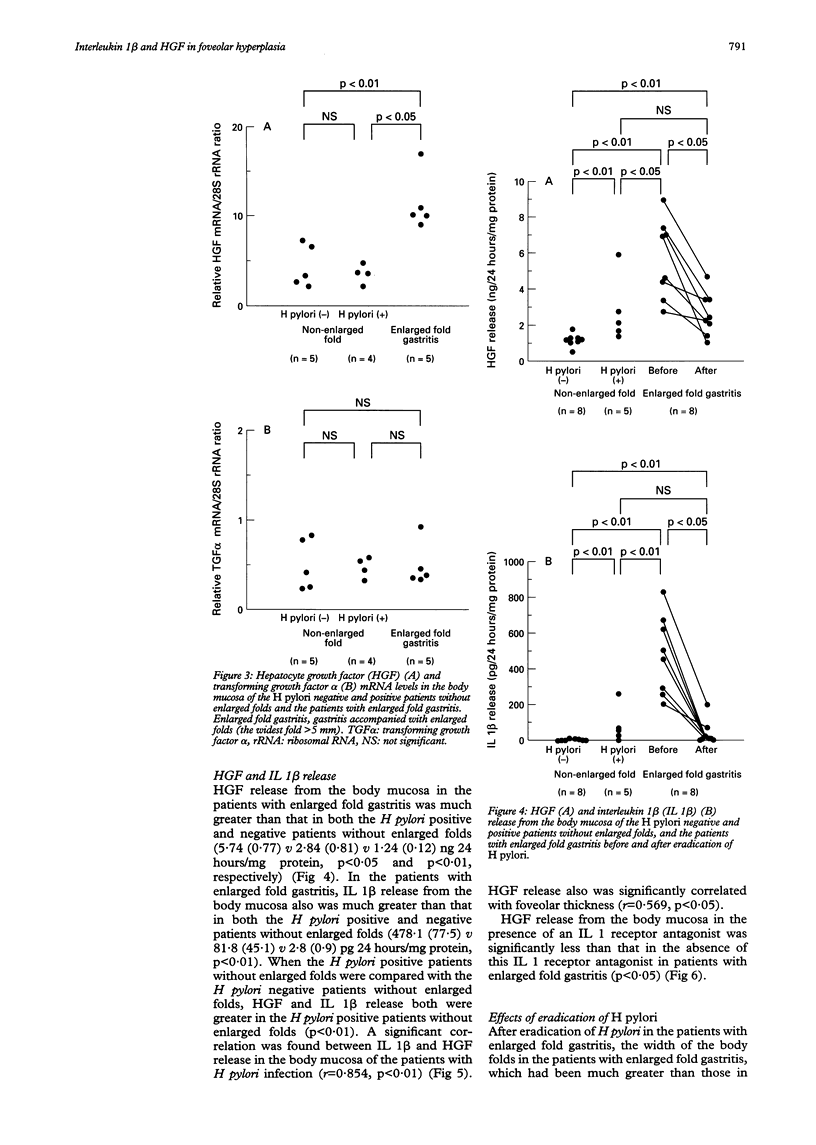
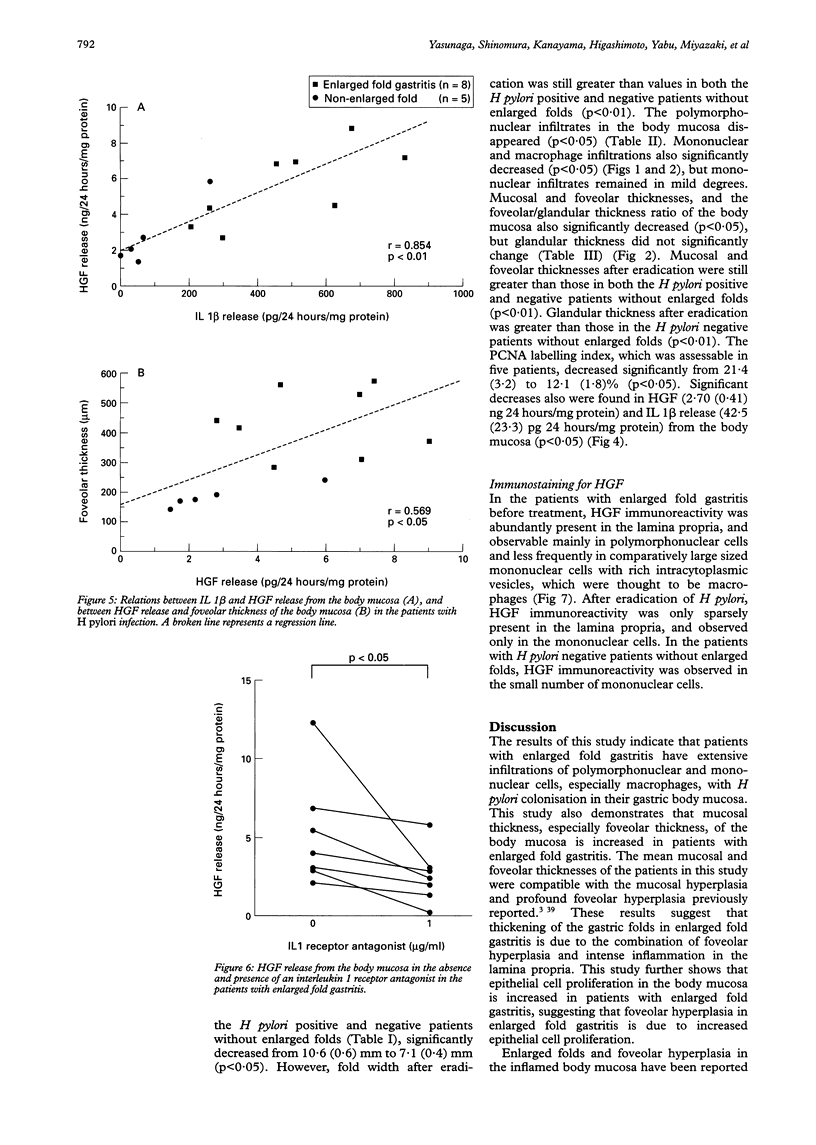
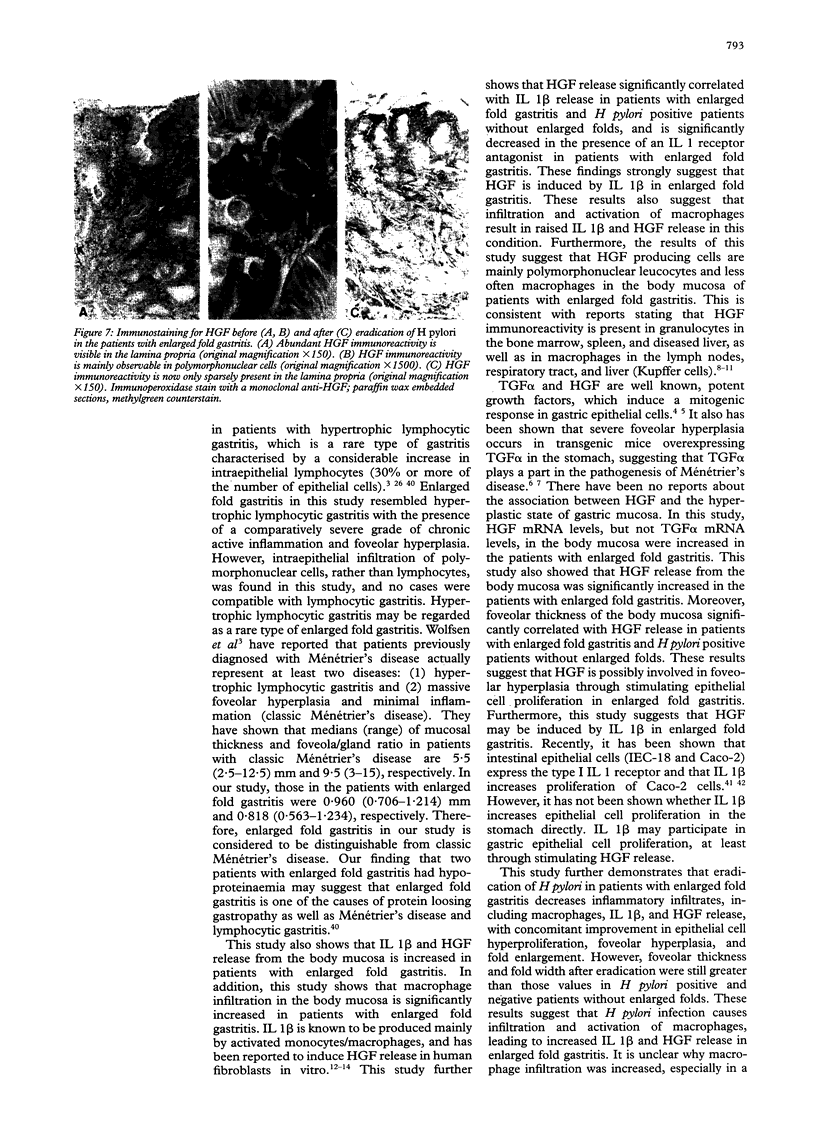
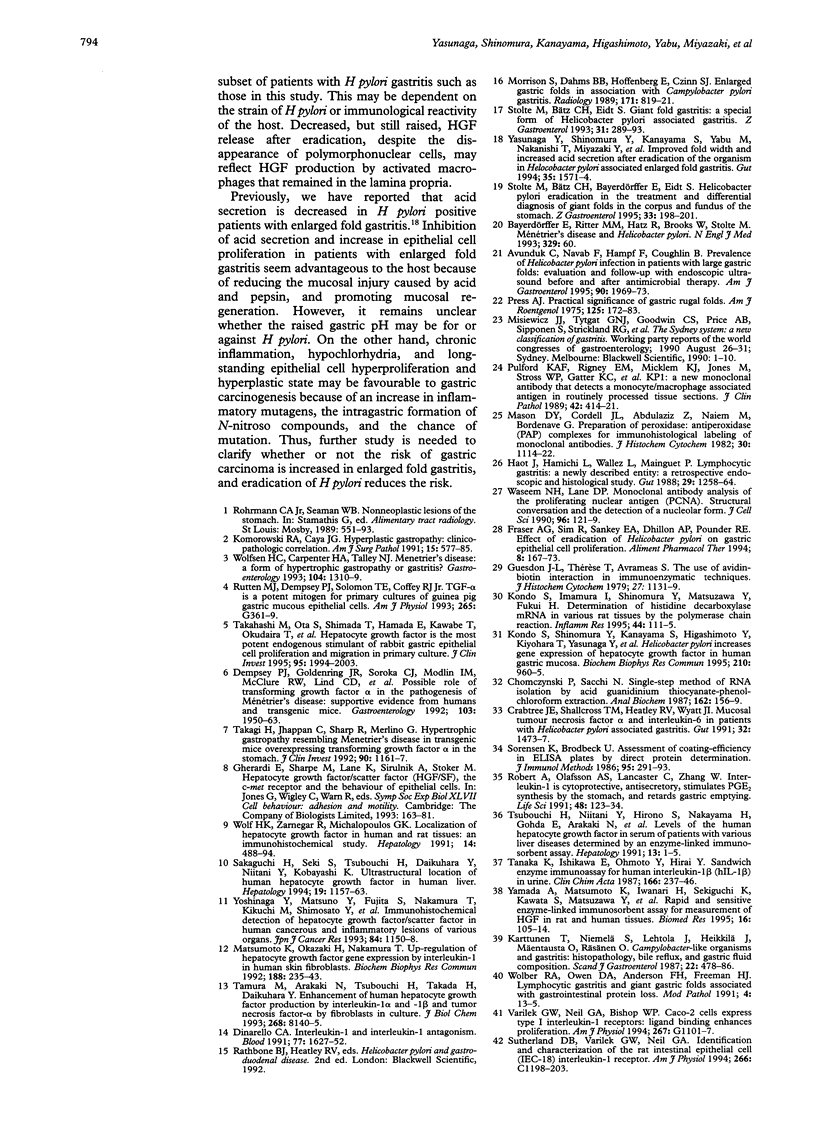
Images in this article
Selected References
These references are in PubMed. This may not be the complete list of references from this article.
- Avunduk C., Navab F., Hampf F., Coughlin B. Prevalence of Helicobacter pylori infection in patients with large gastric folds: evaluation and follow-up with endoscopic ultrasound before and after antimicrobial therapy. Am J Gastroenterol. 1995 Nov;90(11):1969–1973. [PubMed] [Google Scholar]
- Bayerdörffer E., Ritter M. M., Hatz R., Brooks W., Stolte M. Ménétrier's disease and Helicobacter pylori. N Engl J Med. 1993 Jul 1;329(1):60–60. doi: 10.1056/nejm199307013290116. [DOI] [PubMed] [Google Scholar]
- Chomczynski P., Sacchi N. Single-step method of RNA isolation by acid guanidinium thiocyanate-phenol-chloroform extraction. Anal Biochem. 1987 Apr;162(1):156–159. doi: 10.1006/abio.1987.9999. [DOI] [PubMed] [Google Scholar]
- Crabtree J. E., Shallcross T. M., Heatley R. V., Wyatt J. I. Mucosal tumour necrosis factor alpha and interleukin-6 in patients with Helicobacter pylori associated gastritis. Gut. 1991 Dec;32(12):1473–1477. doi: 10.1136/gut.32.12.1473. [DOI] [PMC free article] [PubMed] [Google Scholar]
- Dempsey P. J., Goldenring J. R., Soroka C. J., Modlin I. M., McClure R. W., Lind C. D., Ahlquist D. A., Pittelkow M. R., Lee D. C., Sandgren E. P. Possible role of transforming growth factor alpha in the pathogenesis of Ménétrier's disease: supportive evidence form humans and transgenic mice. Gastroenterology. 1992 Dec;103(6):1950–1963. doi: 10.1016/0016-5085(92)91455-d. [DOI] [PubMed] [Google Scholar]
- Dinarello C. A. Interleukin-1 and interleukin-1 antagonism. Blood. 1991 Apr 15;77(8):1627–1652. [PubMed] [Google Scholar]
- Fraser A. G., Sim R., Sankey E. A., Dhillon A. P., Pounder R. E. Effect of eradication of Helicobacter pylori on gastric epithelial cell proliferation. Aliment Pharmacol Ther. 1994 Apr;8(2):167–173. doi: 10.1111/j.1365-2036.1994.tb00274.x. [DOI] [PubMed] [Google Scholar]
- Gherardi E., Sharpe M., Lane K., Sirulnik A., Stoker M. Hepatocyte growth factor/scatter factor (HGF/SF), the c-met receptor and the behaviour of epithelial cells. Symp Soc Exp Biol. 1993;47:163–181. [PubMed] [Google Scholar]
- Guesdon J. L., Ternynck T., Avrameas S. The use of avidin-biotin interaction in immunoenzymatic techniques. J Histochem Cytochem. 1979 Aug;27(8):1131–1139. doi: 10.1177/27.8.90074. [DOI] [PubMed] [Google Scholar]
- Haot J., Hamichi L., Wallez L., Mainguet P. Lymphocytic gastritis: a newly described entity: a retrospective endoscopic and histological study. Gut. 1988 Sep;29(9):1258–1264. doi: 10.1136/gut.29.9.1258. [DOI] [PMC free article] [PubMed] [Google Scholar]
- Karttunen T., Niemelä S., Lehtola J., Heikkilä J., Mäentausta O., Räsänen O. Campylobacter-like organisms and gastritis: histopathology, bile reflux, and gastric fluid composition. Scand J Gastroenterol. 1987 May;22(4):478–486. doi: 10.3109/00365528708991494. [DOI] [PubMed] [Google Scholar]
- Komorowski R. A., Caya J. G. Hyperplastic gastropathy. Clinicopathologic correlation. Am J Surg Pathol. 1991 Jun;15(6):577–585. doi: 10.1097/00000478-199106000-00006. [DOI] [PubMed] [Google Scholar]
- Kondo S., Imamura I., Shinomura Y., Matsuzawa Y., Fukui H. Determination of histidine decarboxylase mRNA in various rat tissues by the polymerase chain reaction. Inflamm Res. 1995 Mar;44(3):111–115. doi: 10.1007/BF01782020. [DOI] [PubMed] [Google Scholar]
- Kondo S., Shinomura Y., Kanayama S., Higashimoto Y., Kiyohara T., Yasunaga Y., Kitamura S., Ueyama H., Imamura I., Fukui H. Helicobacter pylori increases gene expression of hepatocyte growth factor in human gastric mucosa. Biochem Biophys Res Commun. 1995 May 25;210(3):960–965. doi: 10.1006/bbrc.1995.1750. [DOI] [PubMed] [Google Scholar]
- Lal R., John S. A. Biological applications of atomic force microscopy. Am J Physiol. 1994 Jan;266(1 Pt 1):C1–21. doi: 10.1152/ajpcell.1994.266.1.C1. [DOI] [PubMed] [Google Scholar]
- Mason D. Y., Cordell J. L., Abdulaziz Z., Naiem M., Bordenave G. Preparation of peroxidase: antiperoxidase (PAP) complexes for immunohistological labeling of monoclonal antibodies. J Histochem Cytochem. 1982 Nov;30(11):1114–1122. doi: 10.1177/30.11.6183312. [DOI] [PubMed] [Google Scholar]
- Matsumoto K., Okazaki H., Nakamura T. Up-regulation of hepatocyte growth factor gene expression by interleukin-1 in human skin fibroblasts. Biochem Biophys Res Commun. 1992 Oct 15;188(1):235–243. doi: 10.1016/0006-291x(92)92375-8. [DOI] [PubMed] [Google Scholar]
- Morrison S., Dahms B. B., Hoffenberg E., Czinn S. J. Enlarged gastric folds in association with Campylobacter pylori gastritis. Radiology. 1989 Jun;171(3):819–821. doi: 10.1148/radiology.171.3.2717759. [DOI] [PubMed] [Google Scholar]
- Press A. J. Practical significance of gastric rugal folds. Am J Roentgenol Radium Ther Nucl Med. 1975 Sep;125(1):172–183. doi: 10.2214/ajr.125.1.172. [DOI] [PubMed] [Google Scholar]
- Pulford K. A., Rigney E. M., Micklem K. J., Jones M., Stross W. P., Gatter K. C., Mason D. Y. KP1: a new monoclonal antibody that detects a monocyte/macrophage associated antigen in routinely processed tissue sections. J Clin Pathol. 1989 Apr;42(4):414–421. doi: 10.1136/jcp.42.4.414. [DOI] [PMC free article] [PubMed] [Google Scholar]
- Robert A., Olafsson A. S., Lancaster C., Zhang W. R. Interleukin-1 is cytoprotective, antisecretory, stimulates PGE2 synthesis by the stomach, and retards gastric emptying. Life Sci. 1991;48(2):123–134. doi: 10.1016/0024-3205(91)90405-z. [DOI] [PubMed] [Google Scholar]
- Rutten M. J., Dempsey P. J., Solomon T. E., Coffey R. J., Jr TGF-alpha is a potent mitogen for primary cultures of guinea pig gastric mucous epithelial cells. Am J Physiol. 1993 Aug;265(2 Pt 1):G361–G369. doi: 10.1152/ajpgi.1993.265.2.G361. [DOI] [PubMed] [Google Scholar]
- Sakaguchi H., Seki S., Tsubouchi H., Daikuhara Y., Niitani Y., Kobayashi K. Ultrastructural location of human hepatocyte growth factor in human liver. Hepatology. 1994 May;19(5):1157–1163. [PubMed] [Google Scholar]
- Sorensen K., Brodbeck U. Assessment of coating-efficiency in ELISA plates by direct protein determination. J Immunol Methods. 1986 Dec 24;95(2):291–293. doi: 10.1016/0022-1759(86)90419-9. [DOI] [PubMed] [Google Scholar]
- Stolte M., Bätz C. H., Bayerdörffer E., Eidt S. Helicobacter pylori eradication in the treatment and differential diagnosis of giant folds in the corpus and fundus of the stomach. Z Gastroenterol. 1995 Apr;33(4):198–201. [PubMed] [Google Scholar]
- Stolte M., Bätz C., Eidt S. Giant fold gastritis--a special form of Helicobacter pylori associated gastritis. Z Gastroenterol. 1993 May;31(5):289–293. [PubMed] [Google Scholar]
- Takagi H., Jhappan C., Sharp R., Merlino G. Hypertrophic gastropathy resembling Ménétrier's disease in transgenic mice overexpressing transforming growth factor alpha in the stomach. J Clin Invest. 1992 Sep;90(3):1161–1167. doi: 10.1172/JCI115936. [DOI] [PMC free article] [PubMed] [Google Scholar]
- Takahashi M., Ota S., Shimada T., Hamada E., Kawabe T., Okudaira T., Matsumura M., Kaneko N., Terano A., Nakamura T. Hepatocyte growth factor is the most potent endogenous stimulant of rabbit gastric epithelial cell proliferation and migration in primary culture. J Clin Invest. 1995 May;95(5):1994–2003. doi: 10.1172/JCI117884. [DOI] [PMC free article] [PubMed] [Google Scholar]
- Tamura M., Arakaki N., Tsubouchi H., Takada H., Daikuhara Y. Enhancement of human hepatocyte growth factor production by interleukin-1 alpha and -1 beta and tumor necrosis factor-alpha by fibroblasts in culture. J Biol Chem. 1993 Apr 15;268(11):8140–8145. [PubMed] [Google Scholar]
- Waseem N. H., Lane D. P. Monoclonal antibody analysis of the proliferating cell nuclear antigen (PCNA). Structural conservation and the detection of a nucleolar form. J Cell Sci. 1990 May;96(Pt 1):121–129. doi: 10.1242/jcs.96.1.121. [DOI] [PubMed] [Google Scholar]
- Wolber R. A., Owen D. A., Anderson F. H., Freeman H. J. Lymphocytic gastritis and giant gastric folds associated with gastrointestinal protein loss. Mod Pathol. 1991 Jan;4(1):13–15. [PubMed] [Google Scholar]
- Wolf H. K., Zarnegar R., Michalopoulos G. K. Localization of hepatocyte growth factor in human and rat tissues: an immunohistochemical study. Hepatology. 1991 Sep;14(3):488–494. [PubMed] [Google Scholar]
- Wolfsen H. C., Carpenter H. A., Talley N. J. Menetrier's disease: a form of hypertrophic gastropathy or gastritis? Gastroenterology. 1993 May;104(5):1310–1319. doi: 10.1016/0016-5085(93)90339-e. [DOI] [PubMed] [Google Scholar]
- Yasunaga Y., Shinomura Y., Kanayama S., Yabu M., Nakanishi T., Miyazaki Y., Murayama Y., Bonilla-Palacios J. J., Matsuzawa Y. Improved fold width and increased acid secretion after eradication of the organism in Helicobacter pylori associated enlarged fold gastritis. Gut. 1994 Nov;35(11):1571–1574. doi: 10.1136/gut.35.11.1571. [DOI] [PMC free article] [PubMed] [Google Scholar]
- Yoshinaga Y., Matsuno Y., Fujita S., Nakamura T., Kikuchi M., Shimosato Y., Hirohashi S. Immunohistochemical detection of hepatocyte growth factor/scatter factor in human cancerous and inflammatory lesions of various organs. Jpn J Cancer Res. 1993 Nov;84(11):1150–1158. doi: 10.1111/j.1349-7006.1993.tb02815.x. [DOI] [PMC free article] [PubMed] [Google Scholar]





